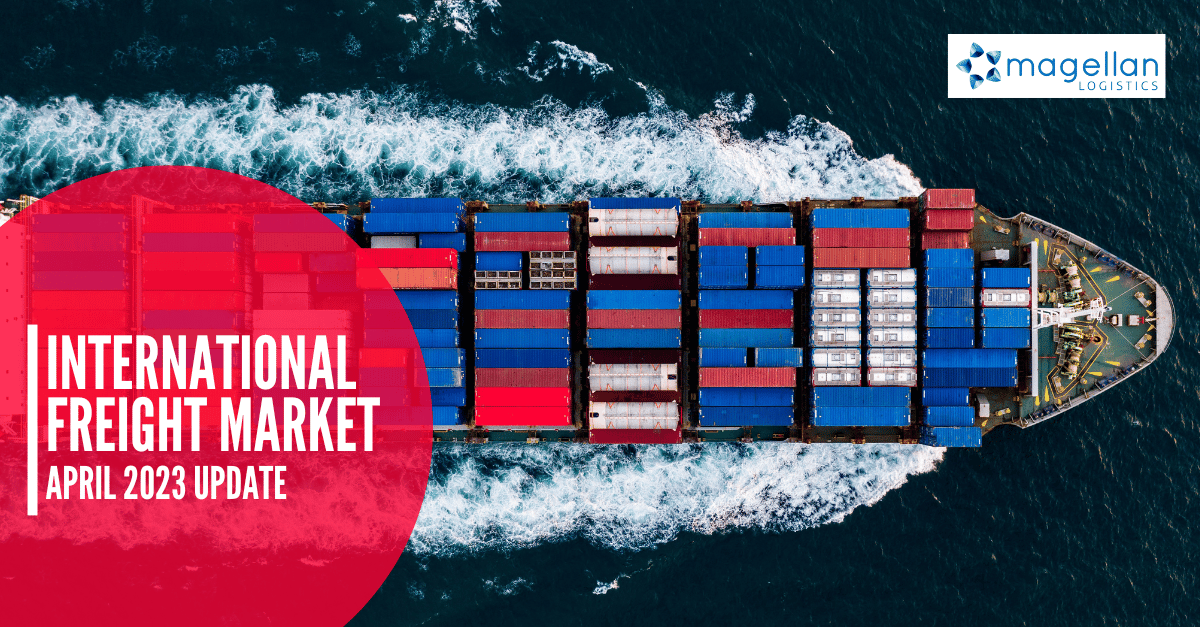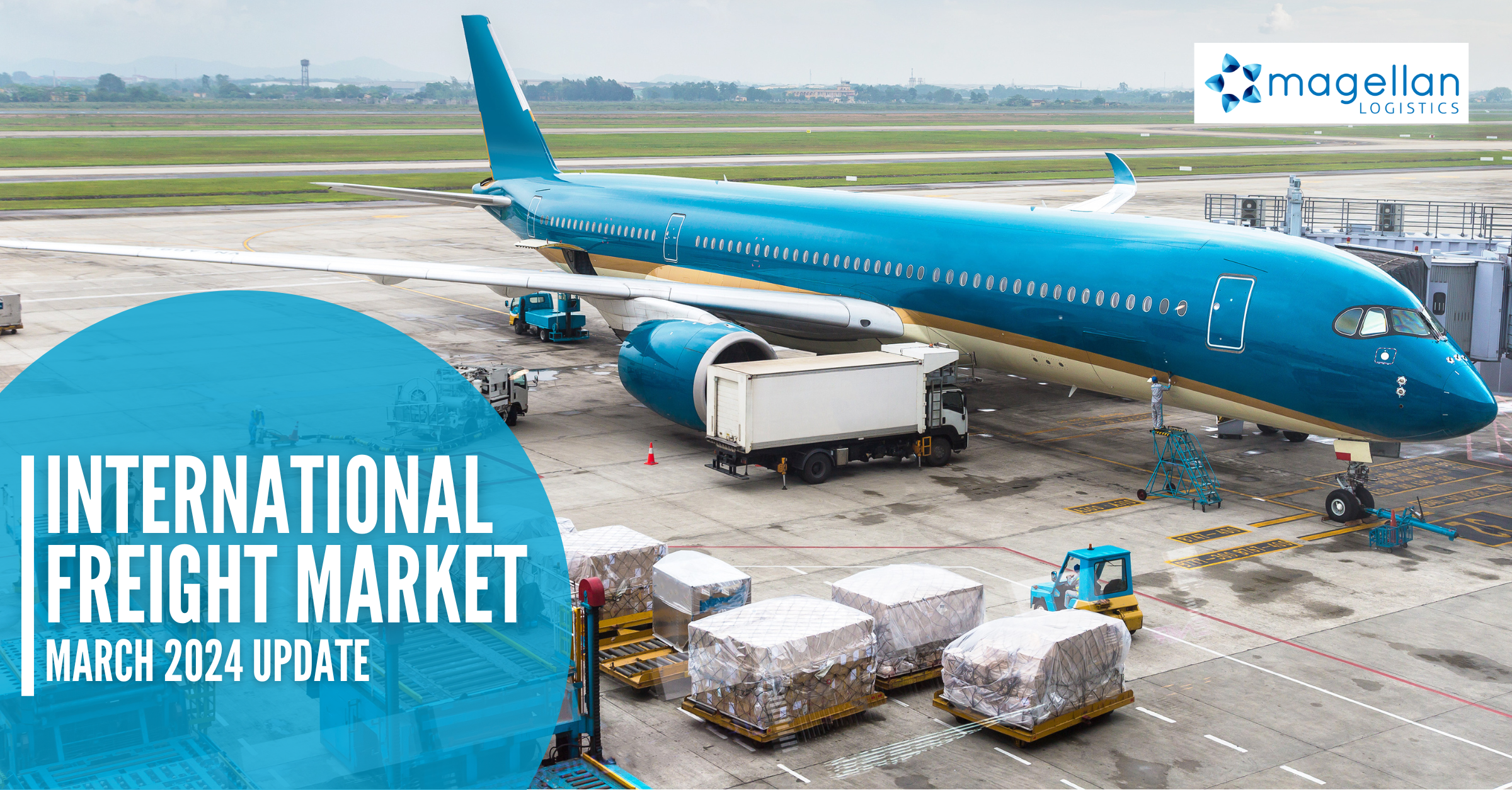In this international freight market update, we continue to see conditions characterised by high inflation and economic tightening, contributing to a drop in trade volumes.
Freight market update
Maersk, OOCL, Hapag Lloyd and CMA CGM reported reduced container volumes for 2022 and are forecasting further reductions in 2023.
Freight rates from China have hit lows. They are expected to hold stable until after Chinese Labor Day – speculation exists that rates may increase with an anticipated increase of blank (cancelled) sailings to reduce supply. Rate restoration charges are being announced for some trade lanes to maintain services.
On a global scale, a surge of new vessels will be delivered in the coming months replacing aging fleets that were retained to support increased demand during the pandemic.
The Port of Melbourne reported 219,606 TEU in February 2023 – an 18% decline on February 2022. Overall, port operating conditions are improving in Australia, with delays for on/off window vessels decreasing and empty container parks less congested.
World Shipping Council released their proposal and sought feedback on new global measures to avoid contamination of sea containers by invasive pests and cargoes – Verified Pest Prevention (VPP) declaration.
Committees under the International Maritime Organisation (IMO) are considering proposals for some chemicals and other products to be added to the definition of dangerous goods.
Media coverage suggests that the IMO will increase carbon reduction targets in the coming months, with growing speculation that this will translate to substantial increases in BAFs paid by forwarders and shippers.
ANL’s APR Service, which connects North Queensland to South East Asia, is set to receive its second upgrade of the year with the addition of a Gladstone call.
In line with the projected increase in trade with the sub-continent, SeaLead Shipping offers a new service connecting major ports in Australia directly to India and Pakistan.
Asia Pacific to Asia Pacific
Rates continue to slide but at a much slower pace. There are some GRI implemented locally, but some of them remain unsuccessful. Space for some destinations is reported tight due to the blank sailing arrangements. Ramadan may impact cargo and schedules to Malaysia, Indonesia, India, Bangladesh, and Pakistan.
Direct services are advised for time-sensitive cargoes to prevent delays at transhipment ports. The carriers have a positive outlook for the coming months, with China resuming production.
China / North Asia
The carriers have announced a GRI for April, but with no significant increases in freight volumes, there is some doubt as to whether it will come to pass.
There remains the possibility that some smaller carriers will reduce services or capacity to maintain rates and offset the costs of the vessel charter. No blank sailings have been announced.
Air freight rates are reducing as more services and flights return to this trade lane.
South East Asia
Ocean freight rates are stable, and no GRIs or blank sailings are planned. Airfreight rates are improving as more flights and services return to the trade lane.
India
All terminals at the Port of Nhava Sheva continue encountering severe congestion and capacity constraints. Low landside productivity may cause vessels to redirect to other ports, potentially exacerbating delays and congestion beyond Nhava Sheva.
Export gate-in times have also been reduced, and waiting times may increase due to road congestion. A shortage of reefer plugs and disruption from dredging work due to start next week has further exacerbated the risk of cargo delays for carriers and shippers.
This increased pressure comes after APM Terminals Mumbai (GTI) decommissioned one of its berths for crane upgrades. Additionally, upcoming plans to start significant maintenance dredging work for PSA Mumbai’s berth pockets could further curb vessel movements.
All carriers said vessels were also facing the risk of sailing light due to terminal restrictions on gate moves.
North America
The USA returns to stability after months of delays, equipment shortages and congestion. No immediate GRIs have been announced, and some rates have dropped, although this is not across the board. Air freight rates are steady, and congestion is still a problem, overcome with advanced booking. Rates are very stable and decreasing slightly. Capacity is available, and carriers are actively looking for freight.
Europe and UK
Vessels are not full from the UK, so no rate increases are expected. There have been no blank sailings announced.
Overall, Europe to SEA trades remains steady. Space is still available. There are no issues with capacity, only vessel delays. Blank sailings/suspension of services are still in place. Rates continue to decrease.
Europe to AU/NZ: No space issues any longer on both services. Rates on both services are decreasing. Airfreight prices fell slightly in March, and the number of flights remained consistent, with no significant backlogs or delays at the hub.
Pakistan
Airfreight prices fell slightly in March, and the number of flights remained consistent, with no significant backlogs or delays at the hub. Vessels call ports regularly and maintain their schedules with no blank sailings. Outbound volumes remain flat. Consequently, no rate increases are likely for the time being.
Bangladesh
High inflation has slowed demand for exports. Despite this, services are stable, with no blank sailings or issues with equipment shortages, or imminent rate increases. Air freight rates and reliability are now close to pre-pandemic levels, and space is available.
Australia ports
Patrick Terminals increased its terminal charge in March. Hutchison Ports has flagged increased landside fees for Brisbane and Sydney from 22 May.
Economic outlook
Europe: Persistent inflation pressures are stalling growth throughout Europe, with headline consumer price inflation, eased marginally to 8.5% year on year (y/y) in February
Rising interest rates, tightening credit, and housing market corrections will impede near-term growth. And several factors could put the zone into recession, including an intensification of the conflict in Ukraine, widespread declines in house prices, and spillovers from economic weakness outside the region.
Americas: After fourth-quarter growth in 2022, the US economy decelerated in early 2023. A slight economic contraction is expected in the second quarter of 2023 as declines in residential construction, business equipment investment, and inventory accumulation offset consumer spending gains. Growth for the rest of 2023 will be restrained, leading to increased unemployment.
Asia Pacific: Mainland China’s economic growth is reviving after the end of zero-COVID policies. The service sector output rose 5.5% y/y in the first two months of 2023, while retail sales increased by 3.5%. Industrial production has picked up but remains restrained by a continuing decline in exports. Home prices have stabilised, and housing and construction completions have improved. After just 3.0% growth in 2022, real GDP should increase 5.3% in 2023 and 5.5% in 2024 before resuming a long-term deceleration.
Magellan Logistics provides freight and logistics services to all industries, including sea freight, air freight, customs clearance and the all-important digital freight portal providing 24/7 visibility of all your shipments. Keeping customers abreast of changing market conditions is critical in what we do. If you have questions about the Freight Market Update, please get in touch on 1300 651 888, our dedicated and professional team, would love an opportunity to assist your business.
Sources:
With thanks to the FTA for their Market Update













